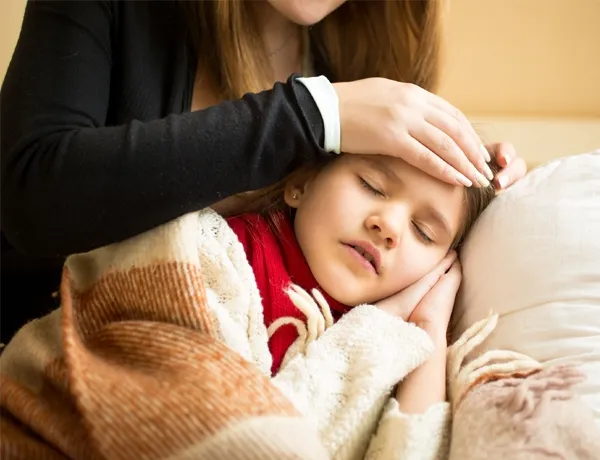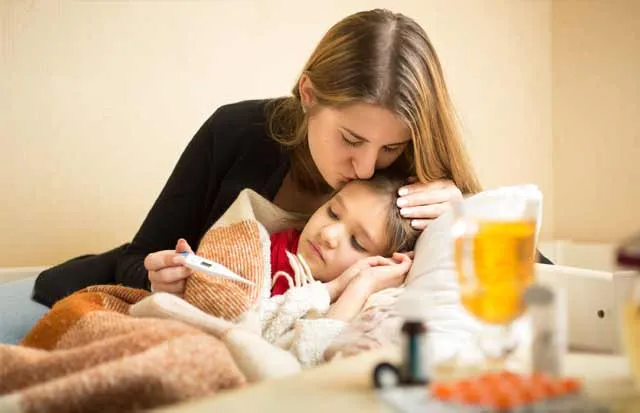
Fever in Children
Fever is a normal response to many conditions, the most common of which is infection. Fever occurs when the body’s temperature is elevated as a result of the body’s thermostat being reset to a higher-than-usual temperature.
Nearly every child will develop a fever at some point. The challenge for parents is to know when to be concerned. Generally speaking most cases of fever in children improve without any medication and without a visit to the healthcare facilities . Fever is also very important for children’s immune system in fighting infections .
Because of that till now there is no consensus in the world regarding when to start treatment for fever or even shall we treat fever or not . So far all medical resources are giving avery braod guidelines for parents and for health care providers so that it is acase by case experience more than fixed 100% sure guidelines . Fever still needs a lot of research in the future to know the exact cause and effect of it and what is the ideal way to treat it if any .
What is Fever?
Because of the normal variation in body temperature, there is no single value that is defined as fever. In general, a fever means a temperature above 100.4ºF (38ºC). You might get slightly different numbers depending on how you take your child’s temperature – oral (mouth), axillary (armpit), ear, forehead, or rectal.
Axillary, ear, and forehead temperature measurements are easier to obtain than rectal or oral temperatures.
You should know that there is a difference between body temperature in the morning and in the evening ; usually 0.5 C higher at evening in all humans . So in the same human temperature maybe 37.5 C in the morning and 38 C in the evening which is a normal variation in all of us .

Fever Causes
Infection is the most common cause of fever in children. Common viral and bacterial illnesses are the most likely illnesses to cause fever. These include:
- Colds
- Gastroenteritis
- Ear infections
- Croup
- Bronchiolitis
- Urinary tract infections
There is little or no scientific evidence to support the widespread belief that teething causes fever. Alternative causes of fever should always be sought in all cases where teathing is there .
Bundling a child who is less than three months old in too many clothes or blankets can increase the child’s temperature slightly.
Some childhood immunizations can cause fever.
Your child should be seen as soon as possible if he or she:
- Does not respond to you, has trouble waking up, or is limp
- Has trouble breathing
- Has blue lips, tongue, or nails
- Starts to lean forward and drool
- Is an infant, and the soft spot on his or her head seems to be bulging or caving in
- Has a stiff neck
- Has a severe headache
- Has severe belly pain
- Has a rash or purple spots that look like bruises on the skin (that were not there before he or she got sick)
- Refuses to drink anything or seems too sick to drink enough
- Will not stop crying
- Is very cranky or irritable
Call or visit your child’s doctor or nurse if your child:
- Has diarrhea that lasts more than two to three days or seems to be getting worse
- Has vomiting that goes on for more than one day
- Seems to be dehydrated (signs include urinating less than usual, not having tears when crying, being less alert and less active than usual)
- Has a specific symptom, such as a sore throat or ear pain
- Has pain when he or she urinates


SHOULD I TREAT MY CHILD’S FEVER?
Fever may play a role in fighting infection, but it can also make a child uncomfortable.The height of a child’s fever is not always the best indicator of whether the child needs to be treated and/or evaluated. Instead, it is important to note how a child behaves and appears. Fever is usually accompanied by other symptoms. Some of these symptoms require evaluation by a pediatrician , even if there is no fever. Some of these symptoms are :
So in most cases, it is not necessary to treat a child’s fever if he is eating , has normal activity and has no other worning symptoms as mentioned in the table above .
Treatment Options for Fever
- Observation :
Which is the most common way of dealing with fever , as mentioned previously if your child is active , feeding well and has no worning symptoms then maybe it is better to let the fever boost his immune system to fight the cause of his illness.
- Medications :
The most effective way to treat fever is to use a medication such as acetaminophen (sample brand name: Adol or panadol ) or ibuprofen (sample brand names: Advil, Brufen). These treatments can reduce the child’s discomfort and lower the child’s temperature by 2 to 3°F (1 to 1.5°C).
Aspirin is not recommended for children under age 18 years due to concerns that it can cause a rare but serious illness known as Reye syndrome.
Acetaminophen may be given every four to six hours as needed . Acetaminophen should not be used in children younger than three months of age without consultation with a health care provider. The dose of acetaminophen should be calculated based upon the child’s weight (not age).
Fever-reducing medications should only be given as needed and discontinued once annoying symptoms have resolved.
- Increase fluids :
Having fever can increase a child’s risk of becoming dehydrated. To reduce this risk, parents should encourage their child to drink an adequate amount of fluids. Children with fever may not feel hungry, and it is not necessary to force them to eat. However, fluids such as milk (cow’s or breast), formula, and water should be offered frequently. If the child is unwilling or unable to drink fluids for more than a few hours, the parent should consult the child’s health care provider.
- Rest :
Having a fever causes most children to feel tired and achy. During this time, parents should encourage their child to rest as much as the child wants. It is not necessary to force the child to sleep or rest if he or she begins to feel better. In most cases children may return to school or other activities when the temperature has been normal for 24 hours .
- Sponging and baths :
May be used occasionally if the fever is going very high and not responding to fever medications .
References
https://www.uptodate.com/contents/fever-in-children-beyond-the-basics
https://pediatrics.aappublications.org/content/127/3/580
https://www.stanfordchildrens.org/en/topic/default?id=fever-in-children-90-P02512
For further information about our Pediatric services or for appointments, please contact us via telephone: 800 4272 or email: [email protected]










